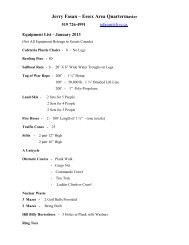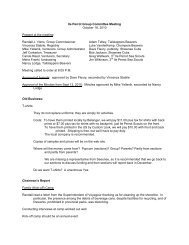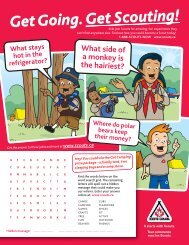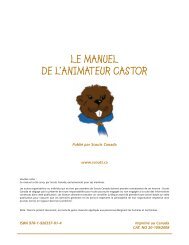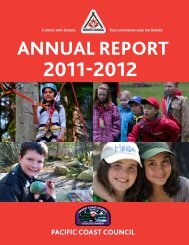Beaver Leader's Handbook - Scouts Canada
Beaver Leader's Handbook - Scouts Canada
Beaver Leader's Handbook - Scouts Canada
You also want an ePaper? Increase the reach of your titles
YUMPU automatically turns print PDFs into web optimized ePapers that Google loves.
More About Birds<br />
Contact bird enthusiasts through your local bird watching societies. If your city has a zoo or a<br />
museum of natural science, you may find somebody there who is willing to spend an hour with<br />
the colony.<br />
Even if you can’t locate an expert to visit, you can do some research at the local public library.<br />
Plan to familiarize the <strong>Beaver</strong>s with a few birds common to your area; do some research so you<br />
know some answers.<br />
Apart from the obvious fact that birds are unique because they are the only animals that have feathers,<br />
bird beaks are very distinctive. Different bird species have different sizes and shapes of beaks.<br />
Explain to the colony that a bird’s beak is designed specifically to help the bird capture and eat<br />
its food. Come to the meeting equipped with appropriate household utensils to illustrate this<br />
point, and have your <strong>Beaver</strong>s try to use each one as a bird would use its beak.<br />
Parrots<br />
The curved shape of a parrot’s beak is ideally designed as a nutcracker for breaking open the<br />
seeds and nuts that make up the main part of its diet. The short, stubby beak of a sparrow also<br />
is a kind of nutcracker for opening seeds.<br />
Robins<br />
Because these birds mainly eat insects they find on the ground, their beaks (like tweezers), help<br />
them to pick up things easily.<br />
Woodpeckers<br />
These birds also dine mainly on insects, but usually favour those found under the bark of trees.<br />
For this reason, the woodpecker’s beak resembles a drill and is used for making holes.<br />
Hummingbirds<br />
The hummingbird’s beak is a long hollow tube, which the bird inserts like a drinking straw to sip<br />
up nectar from flowers.<br />
THE ONE MINUTE NATURALIST<br />
Although some people might think that the only places to observe the natural world are designated<br />
parks, green spaces or zoos, in fact the grounds around a colony’s meeting hall will<br />
probably provide suitable locations.<br />
Whether you meet in a rural school, suburban community centre, or inner city church hall, the<br />
yard just outside the front door is full of opportunities to make simple outdoor observations. It<br />
offers a safe area for leaders who have little knowledge of nature or experience<br />
in the outdoors.<br />
To take an excursion into the yard, you still need to plan, but you can keep it<br />
quite simple and basic. Chances are, the <strong>Beaver</strong>s are already familiar with the<br />
surroundings. They will enjoy discovering things that may have been right under<br />
their noses.<br />
The length of time you spend outside varies with weather and your topic of exploration,<br />
but even 60 seconds exposure to nature concepts is worth 10 minutes of fun<br />
awareness. Following are some ideas for you and your <strong>Beaver</strong>s to explore.<br />
15-5



